Assessment of Land Ecological Security Based on the Boston Model: A Case Study from China
Abstract
1. Introduction
1.1. Background
1.2. Literature Review
2. Materials and Methods
2.1. Study Area Overview
2.2. Data Sources
2.3. Construction of Index System
2.3.1. Construction of Land Ecological Risk Index System
2.3.2. Construction of Land Ecological Health Index System
2.4. Research Methods
2.4.1. Analytic Hierarchy Process
2.4.2. The Entropy Method
2.4.3. Combinatorial Weighting Method
2.4.4. TOPSIS Model
2.4.5. Boston Matrix Analysis
2.4.6. Obstacle Degree-Analysis Model
3. Results and Discussion
3.1. Assessment Results and Discussion
3.1.1. Land Ecological Risk Assessment
3.1.2. Land Ecological Health Assessment Results
3.1.3. Land Ecological Security-Assessment Results Based on Boston Model
3.2. Obstacle Factor Analysis
3.2.1. Analysis of the Risk Obstacle Factors for Land Ecology
3.2.2. Analysis of the Health Obstacle Factors for Land Ecology
4. Conclusions and Policy Implications
4.1. Conclusions
4.2. Policy Suggestion
4.3. Research Prospect
Author Contributions
Funding
Data Availability Statement
Conflicts of Interest
References
- Yun, W.J.; Sang, L.L. Research on Environmental Risk Control in Land Use in China. Environ. Prot. 2018, 46, 26–30. [Google Scholar]
- Han, Y.; Tang, C.C.; Zeng, R. Review of Tourism Ecological Security from the Perspective of Ecological Civilization Construction. J. Resour. Ecol. 2022, 13, 734–745. [Google Scholar]
- Cai, Y.Y.; Luo, C. Ecological Security Condition of Cultivated Land Resources and Spatial Agglomeration Pattern in Jianghan Plain. J. Huazhong Agric. Univ. Soc. Sci. Ed. 2015, 119, 110–120. [Google Scholar]
- Gu, S.Z.; Hu, Y.J.; Zhou, H. Ecological Civilization Construction: Scientific Connotation and Basic Paths. Resour. Sci. 2013, 35, 2–13. [Google Scholar]
- Shang, W. The Value Connotation and Global Significance of Chinese Modernization and the New Form of Human Civilization. J. Soc. Sci. Hunan Norm. Univ. 2023, 52, 22–30. [Google Scholar]
- Zhou, B. Discussion on the sustainable development of regional ecological civilization. J. Commer. Econ. 2011, 544, 102–103. [Google Scholar]
- Yang, R.R. The Evolution of the Neo-Liberal World Order and the Realization of China’s National Interest in the New Era. Forum World Econ. Politics 2022, 350, 126–143. [Google Scholar]
- Ministry of Natural Resources of the People’s Republic of China. Available online: https://www.mnr.gov.cn/dt/ywbb/202108/t202108262678340.html (accessed on 13 May 2023).
- Ministry of Natural Resources of the People’s Republic of China. Available online: https://www.mnr.gov.cn/zt/hd/dqr/47dqr/zygq/201312/t201312302060254.html (accessed on 13 May 2023).
- Central People’s Government of the People’s Republic of China. Available online: http://www.gov.cn/xinwen/2020-11/17/content_5562088.htm (accessed on 12 May 2023).
- Central People’s Government of the People’s Republic of China. Available online: http://www.gov.cn/xinwen/2021-04/30/content_5604050.htm (accessed on 12 May 2023).
- Central People’s Government of the People’s Republic of China. Available online: http://www.gov.cn/zhengce/content/2021-07/30/content_5628461.htm (accessed on 12 May 2023).
- Shi, Q.L.; Lin, Y.Z.; Zhang, E.P.; Yan, H.M.; Zhan, J.Y. Impacts of Cultivated Land Reclamation on the Climate and Grain Production in Northeast China in the Future 30 Years. Adv. Meteorol. 2013, 2013, 853098. [Google Scholar] [CrossRef]
- Tong, G.J.; Zhang, J.H. An Evaluation of the Development of Multifunctional Agriculture Based on the Grey Multi-level Model—A Case Study of Harbin. J. Liaoning Univ. Philos. Soc. Sci. Ed. 2014, 42, 70–76. [Google Scholar]
- Yu, F.W. Study on the Eco-Compensation Policies for the Green Transformation Development of Agriculture in China. Ecol. Econ. 2017, 33, 14–1823. [Google Scholar]
- Ministry of Agriculture and Rural Affairs of the People’s Republic of China. Available online: http://www.moa.gov.cn/ztzl/xy19d/lsfz/201705/t20170511_5603586.htm (accessed on 10 May 2023).
- Yin, C.B.; Li, F.D.; Wang, S.; Hao, A.B. The concept, connotation and principle of agricultural green development in China. Chin. J. Agric. Resour. Reg. Plan. 2021, 42, 1–6. [Google Scholar]
- Sun, H.B.; Yang, G.S.; Zhu, T.M.; Su, W.Z.; Wan, R.R. Assessment of Land Use Ecological Risks in Rapidly Developing Regions: A Case Study on Kunshan City. Resour. Sci. 2010, 32, 540–546. [Google Scholar]
- He, X.; Jiang, G.H.; Zhang, R.J.; Ma, Q.W.; Zhou, T. Temporal and Spatial Variation of Land Ecosystem Health Based on the Pressure-State-Response Model: A Case Study of Pinggu District, Beijing. J. Nat. Resour. 2015, 30, 2057–2068. [Google Scholar]
- Zhang, J.; Tang, Z.H.; Deng, B.; Deng, B.; Liu, S.Y.; Xiang, Y.F. A Case Study of Grassroots Water Conservancy Services Evaluation and Obstacle Factors Diagnosis Based on Gray Correlation-TOPSIS Model in Hunan Province, China. Int. J. Environ. Res. Public Health 2023, 20, 174. [Google Scholar] [CrossRef] [PubMed]
- Xie, J.; Zhang, H.W.; Wang, Z.Q.; Guo, X. Research on Multi-target Selection and Sequencing Based on Analytic Hierarchy Process. J. Phys. Conf. Ser. 2022, 2221, 012044. [Google Scholar] [CrossRef]
- Liu, W.; Cui, W.L.; Chen, M.J.; Hu, Q.F.; Song, Z.Y. Operation Safety Risk Assessment of Water Distribution Networks Based on the Combined Weighting Method (CWM). KSCE J. Civ. Eng. 2023, 27, 2116–2130. [Google Scholar] [CrossRef]
- Wang, E.W.; Zhu, B.W.; Cui, C.S. The Evaluation of Urban Ecological Civilization Construction in Pearl River Delta Based on Entropy Weight TOPSIS Method. Math. Pract. Theory 2020, 50, 28–37. [Google Scholar]
- Yi, S.Z. Of the Limitation of BCG Matrix Approach. Commer. Res. 2005, 16, 101–104. [Google Scholar]
- Ji, J.; Chen, J.F.; Ding, T.H.; Gu, Y. Security assessment and obstacle factors diagnosis of water-energy-food nexus based on pressure-state-response framework in Northwest China. Stoch. Environ. Res. Risk Assess. 2022, 37, 73–88. [Google Scholar] [CrossRef]
- Liu, Y.S.; Yang, Z.S. New Progress and Its Prospects of Land Resources Sciences Research in China. J. Nat. Resour. 2008, 23, 353–360. [Google Scholar]
- Newbold, T.; Hudson, L.N.; Hill, S.L.L.; Contu, S.; Lysenko, I.; Senior, R.A.; Borger, L.; Bennett, D.J.; Choimes, A.; Collen, B.; et al. Global effects of land use on local terrestrial biodiversity. Nature 2015, 520, 45–50. [Google Scholar] [CrossRef] [PubMed]
- He, N.; Zhou, Y.; Wang, L.; Li, Q.; Zuo, Q.; Liu, J.Y.; Li, M.Y. Spatiotemporal evaluation and analysis of cultivated land ecological security based on the DPSIR model in Enshi autonomous prefecture, China. Ecol. Indic. 2022, 145, 109619. [Google Scholar] [CrossRef]
- Cui, F. On land ecological safety in China. J. Nanjing Agric. Univ. Soc. Sci. Ed. 2006, 6, 51–56. [Google Scholar]
- Bian, D.H.; Cao, Y.H.; He, C.G.; Gao, K. Conceptual Distinction of Ecological Health, Ecological Risk and Ecological Security. Environ. Prot. Sci. 2016, 42, 71–75. [Google Scholar]
- Wen, J.F.; Hou, K. Research on the progress of regional ecological security evaluation and optimization of its common limitations. Ecol. Indic. 2021, 127, 107797. [Google Scholar] [CrossRef]
- Wang, G.X.; Cheng, G.D.; Qian, J. Several problems in ecological security assessment research. Chin. J. Appl. Ecol. 2003, 14, 1551–1556. [Google Scholar]
- Liu, H.L.; Xie, Y.L.; Jia, W.Y.; Shi, P.J. Ecological Security Assessment and Spatial-Temporal Evolution of Shanxi Province. Econ. Geogr. 2018, 38, 161–169. [Google Scholar]
- Elbehiry, F.; Elbasiouny, H.; El-Ramady, H.; Brevik, E.C. Mobility, distribution, and potential risk assessment of selected trace elements in soils of the Nile Delta, Egypt. Environ. Monit. Assess. 2019, 191, 713. [Google Scholar] [CrossRef]
- Okosa, I.; Paul, T.; Ikechukwu-Edeh, C.E.; Ehiomogue, P.; Emeka-Chris, C.C.; Okereke, A.C. Ecological and health risk assessment of heavy metals: A case study of residential waste sites in Umuahia, South-East Nigeria. Environ. Monit. Assess. 2023, 195, 360. [Google Scholar] [CrossRef]
- San Juan, M.R.F.; Lavarias, S.M.L.; Aparicio, V.; Larsen, K.E.; Lerner, J.E.C.; Cortelezzi, A. Ecological risk assessment of pesticides in sediments of Pampean streams, Argentina. Chemosphere 2022, 313, 137598. [Google Scholar] [CrossRef]
- Cai, J.H. Progress and prospect of ecological security research at home and abroad: Based on the overall national security concept and the background of ecological civilization construction. J. Fujian Prov. Comm. Party Sch. CPC Fujian Acad. Gov. 2015, 418, 104–110. [Google Scholar]
- Fang, W.; Lou, L.T. Constructing the Evaluation System of Urban Land Ecosystem Based on Entropy Method and Analytic Hierarchy Process—Taking Shaanxi Province as an Example. IOP Conf. Ser. Earth Environ. Sci. 2019, 295, 012072. [Google Scholar]
- Chen, D.J.; Qu, W.L.; Li, Y.C.; Wu, X.Z.; Gou, S.P. Study on forest ecological dynamic security in Gansu Province. Acta Prataculturae Sin. 2016, 25, 188–193. [Google Scholar]
- Shen, C.H.; ZhuFu, H.Y. An Assessment on Regional Financial Ecological Risk. J. Financ. Dev. Res. 2010, 339, 18–22. [Google Scholar]
- Liu, Y.; Xing, Y.G.; Li, J.C. Theoretical Basis and Model Development for Land Ecological Risk Assessment. China Land Sci. 2012, 26, 20–25. [Google Scholar]
- Huang, S.M.; Hu, Q.W.; Li, H.D.; Wang, S.H. Ecological Risk Assessment of Mount Emei Based on RS and GIS. Res. Environ. Sci. 2020, 33, 2745–2751. [Google Scholar]
- Mao, X.L.; Ni, J.R. Recent Progress of Ecological Risk Assessment. Acta Sci. Nat. Univ. Pekin. 2005, 41, 646–654. [Google Scholar]
- Wang, Y.X.; Liu, S.K.; Lu, R.C.; Lin, S.G.; Liang, Q.X.; Bao, B.J. Landscape Ecological Risk Assessment and Terrain Gradient Analysis of Guangxi’s Border Areas in the Past 40 Years from the “Production-Living-Ecological” Space. J. Ecol. Rural Environ. 2021, 37, 1586–1595. [Google Scholar]
- Scott, H.; Biswajit, M.; Pragya, S.; Debolina, K.; Sarita, B. Spatio-temporal Assessment of Landscape Ecological Risk and Associated Drivers: A Case Study of Delhi. Environ. Urban. Asia 2021, 12, 85–106. [Google Scholar]
- Dimri, D.; Kumar, A.; Mishra, D.K.; Sharma, A. Spatio-temporal variation of trace elements distributed over surface water of Upper Ganga River Basin in Western Himalayan Region. J. Mt. Sci. 2022, 20, 145–162. [Google Scholar] [CrossRef]
- Yu, D.; Liang, Z.B.; Xiao, Z.J.; Sun, C.K.; Zheng, Y.Y. Temporal and Spatial Characteristics of Land Ecological Risk in Nanchang City Based on Landscape Ecology. Res. Soil Water Conserv. 2020, 27, 213–220. [Google Scholar]
- Liu, X.Z.; Li, X.S.; Jiang, D.M. Landscape pattern identification and ecological risk assessment using land-use change in the Yellow River Basin. Trans. Chin. Soc. Agric. Eng. 2021, 37, 265–274. [Google Scholar]
- Chen, M.Q.; Liu, T.J. On land health and land sustainable use. China Popul. Resour. Environ. 2003, 13, 64–67. [Google Scholar]
- Kong, H.M.; Zhao, J.Z.; Ma, K.M.; Zhang, P.; Ji, L.Z.; Deng, H.B.; Lu, Z.H. Assessment method of ecosystem health. Chin. J. Appl. Ecol. 2002, 13, 486–490. [Google Scholar]
- Wang, Z.H.; Tian, D.X.; Liu, Y.H. The Contrary Reseaches on the Chinese and Foreign Ecological Security Assessment. Ecol. Econ. 2008, 199, 44–49. [Google Scholar]
- Zaredar, N.; Jozi, S.A.; Khorssani, N.; Shariat, S.M. Climate-induced land health risk in farmland systems: A case study of Qarasou sub-basin in Karkheh River Basin. Hum. Ecol. Risk Assess. Int. J. 2016, 22, 379–392. [Google Scholar] [CrossRef]
- Herrick, J.E.; Shaver, P.; Pyke, D.A.; Pellant, M.; Toledo, D.; Lepak, N. A strategy for defining the reference for land health and degradation assessments. Ecol. Indic. 2019, 97, 225–230. [Google Scholar] [CrossRef]
- Li, K.M.; Wang, X.Y.; Yao, L.L. Spatial-temporal Evolution of Ecosystem Health and Its Influencing Factors in Beijing-Tianjin-Hebei Region. Environ. Sci. 2023, 1–17. [Google Scholar]
- Liu, Y.M.; Xu, N.Y.; Zeng, H. Ecosystem health assessment and its scale dependence in the coastal region of the East China Sea. Acta Ecol. Sin. 2022, 42, 9913–9926. [Google Scholar]
- Peng, J.J.; Zhou, G.H.; Tang, C.L.; He, Y.H. The Analysis of Spatial Conflict Measurement in Fast Urbanization Region Based on Ecological Security—A Case Study of Changsha-Zhuzhou-Xiangtan Urban Agglomeration. J. Nat. Resour. 2012, 27, 1507–1519. [Google Scholar]
- Zhang, J.L.; Zhang, J.Z.; Shen, J.B.; Tian, J.; Jin, K.M.; Zhang, F.S. Soil Health and Agriculture Green Development: Opportunities and Challenges. Acta Pedol. Sin. 2020, 57, 783–796. [Google Scholar]
- Ye, X.; Zhou, H.K.; Zhao, X.Q.; Wen, J.; Chen, Z.; Duan, J.C. Review on grassland ecosystem health. Pratacultural Sci. 2011, 28, 549–560. [Google Scholar]
- Meherul, A.N.; Chayna, J.; Debashis, M.; Kumari, M.S.; Shekhar, S.S.; Uday, M.; Sabyasachi, M.; Gouranga, K. Applying Analytic Hierarchy Process for Identifying Best Management Practices in Erosion Risk Areas of Northwestern Himalayas. Land 2022, 11, 832. [Google Scholar]
- Han, L.; Mei, Q.; Lu, Y.M.; Ji, M. Analysis and Study on AHP-Fuzzy Comprehensive Evaluation. China Saf. Sci. J. 2004, 14, 89–92+3. [Google Scholar]
- Wang, X.Y.; Qin, S.Z.; Wu, N.N. The Measurement and Spatial-Temporal Evolution Features of Touristization Levels in China. Econ. Geogr. 2014, 34, 179–185. [Google Scholar]
- Huang, D.M.; Wang, X.Z.; Chang, X.K.; Qiao, S.Y.; Zhu, Y.Y.; Xing, D.Q. A safety assessment model of filling mining based on comprehensive weighting-set pair analysis. Environ. Sci. Pollut. Res. Int. 2023, 30, 60746–60759. [Google Scholar] [CrossRef]
- Cao, J.; He, B.W.; Qu, N.; Zhang, J.X.; Liu, C.Q.; Liu, Y.W.; Chen, C.L. Benefits Evaluation Method of an Integrated Energy System Based on a Fuzzy Comprehensive Evaluation Method. Symmetry 2022, 15, 84. [Google Scholar] [CrossRef]
- Chao, X.J.; Ran, B.P. The Fluctuation and Regional Difference of Quality of Economic Growth in China. Econ. Res. J. 2011, 46, 26–40. [Google Scholar]
- Li, H.L.; Yin, G.F.; Xie, Q.S.; Niu, M.Q. Manufacturing resource combination evaluation method oriented to networked manufacturing. Comput. Integr. Manuf. Syst. 2008, 14, 955–961. [Google Scholar]
- Yao, Y.; Tang, J.; Duan, Y.C.; Qu, Y.K.; Sun, F.H.; Li, Z.Y. Study on the Relationship between Different Wastewater Treatment Technologies and Effluent Standards in Jilin Liaohe River Basin Based on the Coupled Model of AHP and Fuzzy TOPSIS Method. Sustainability 2023, 15, 1264. [Google Scholar]
- Zhu, Z.; Zhang, L.; Ye, X.W.; Zhang, Y. Evaluation of Comprehensive Land Use Efficiency Based on TOPSIS. Econ. Geogr. 2012, 32, 139–144. [Google Scholar]
- Li, H.B.; Wang, Q.H. Limitation, correction and application of Boston matrix analysis. Sci. Technol. Innov. Her. 2009, 141, 199+201. [Google Scholar]
- Lu, C.Y.; Wen, F.; Yang, Q.Y.; Chen, L.L.; Zong, H.M. An Evaluation of Urban Land Use Performance Based on the Improved TOPSIS Method and Diagnosis of Its Obstacle Indicators: A Case Study of Chongqing. Resour. Sci. 2011, 33, 535–541. [Google Scholar]
- Dai, Y.T.; Zhang, H.; Cheng, J.; Jiang, X.; Ji, X.X.; Zhu, D.L. Whether ecological measures have influenced the environmental Kuznets curve (EKC)? An analysis using land footprint in the Weihe River Basin, China. Ecol. Indic. 2022, 139, 108891. [Google Scholar] [CrossRef]
- Cheng, X.Y.; Gao, L.N.; Jiang, R.K. Historical Logic and Basic Experience in a Century of the Institutional Construction of Land Rule of Law in China. China Land Sci. 2021, 35, 11–18. [Google Scholar]
- Kuang, Y.P.; Yi, M.D. Precision agriculture promoting the development of modern agriculture: Theoretical mechanism and practical evidence. Res. Agric. Mod. 2018, 39, 551–558. [Google Scholar]
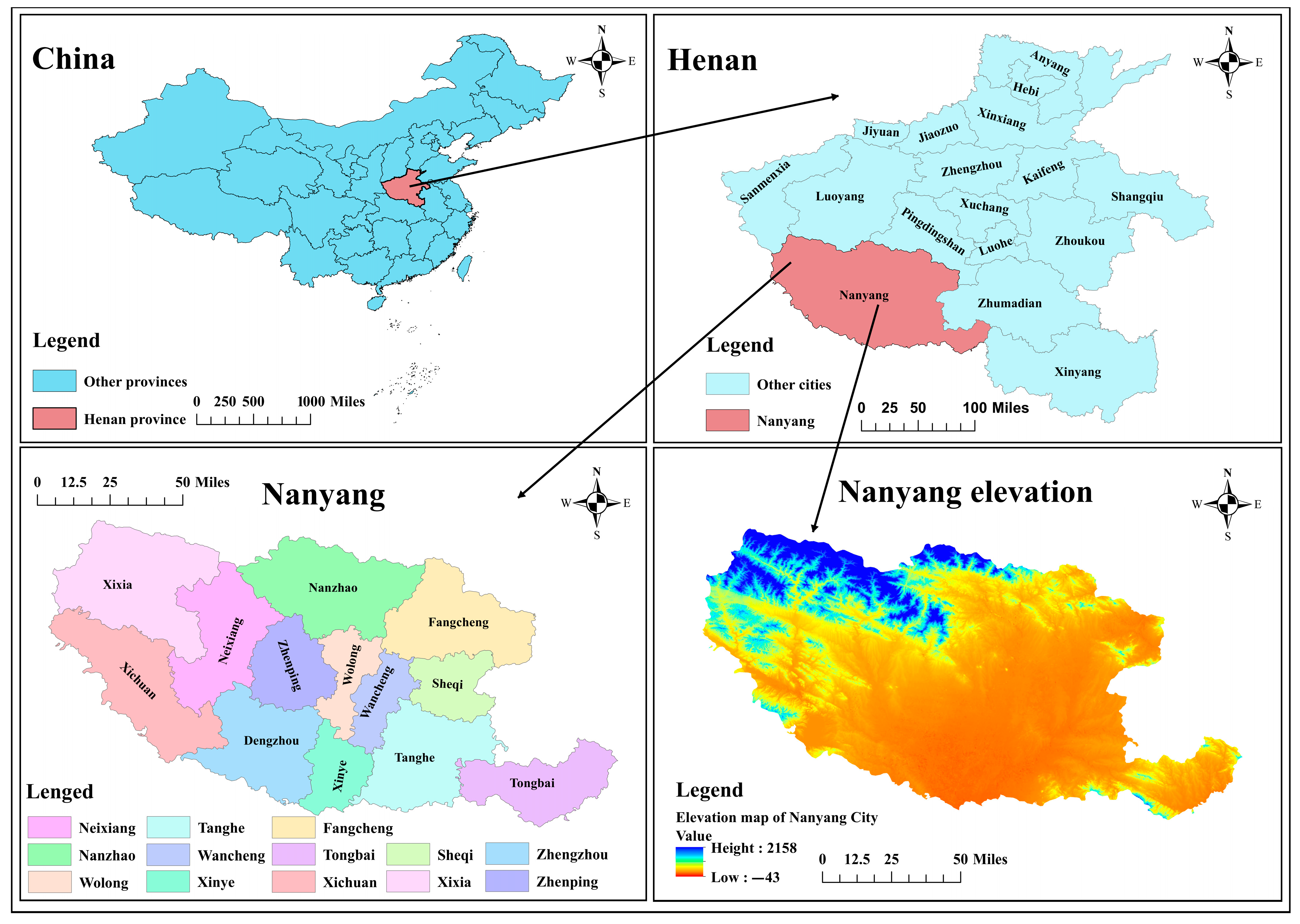
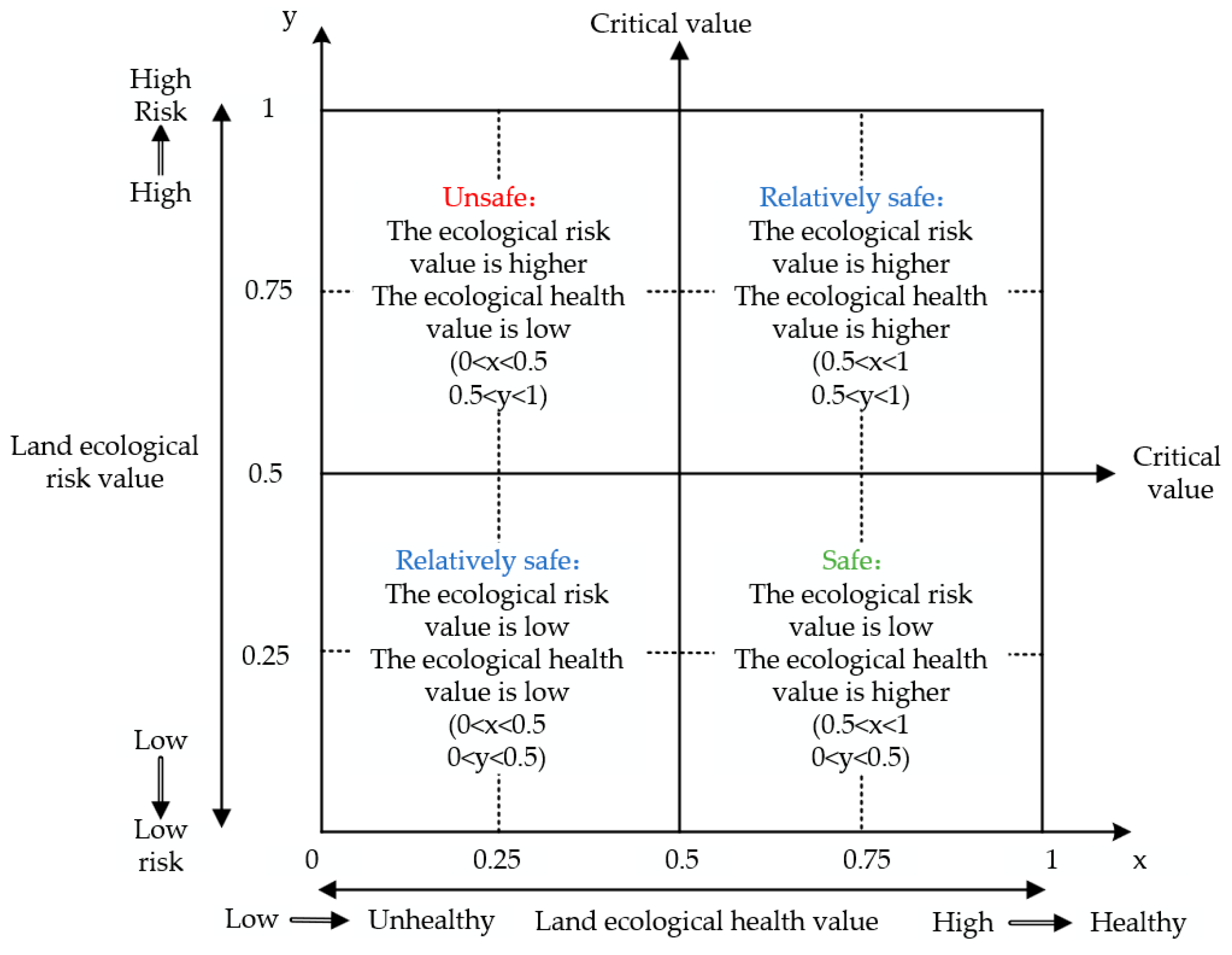
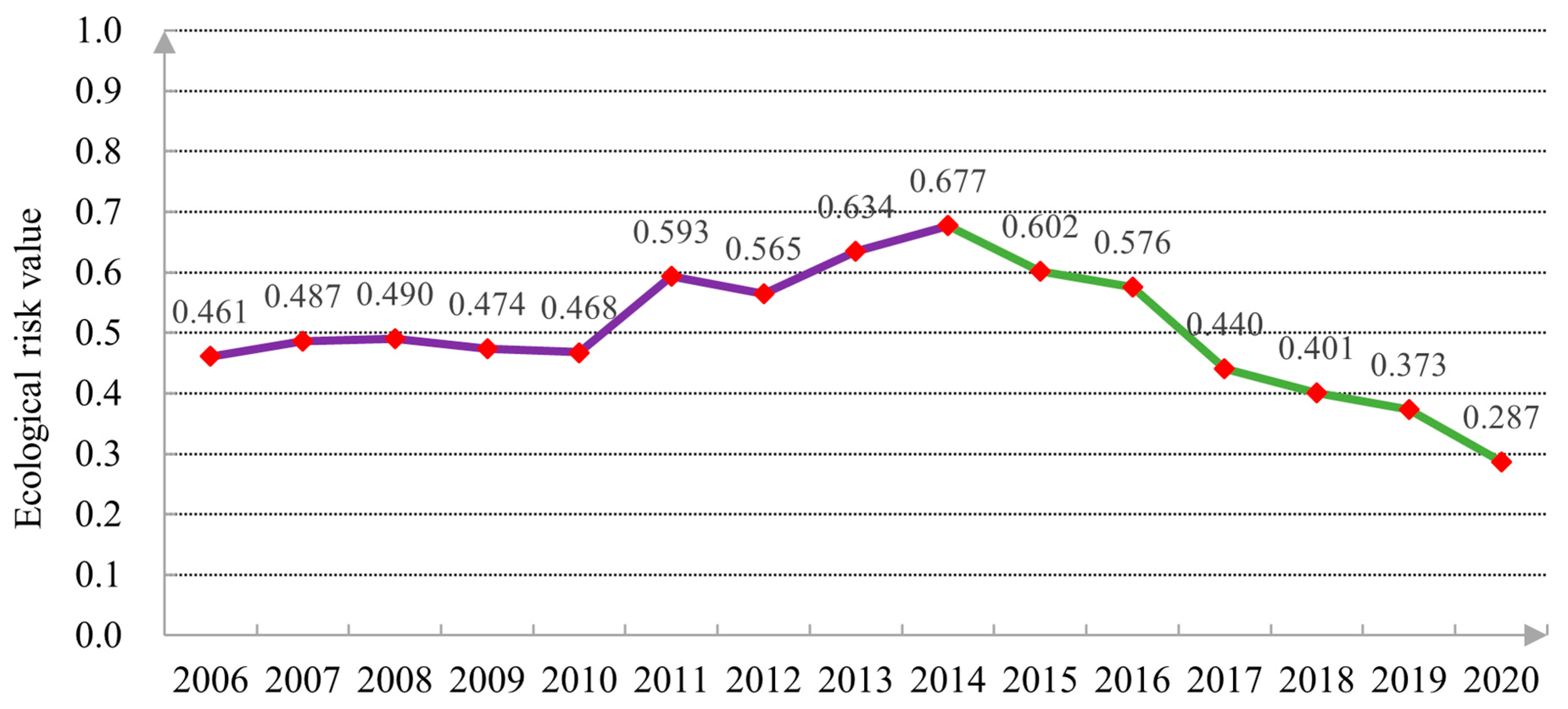
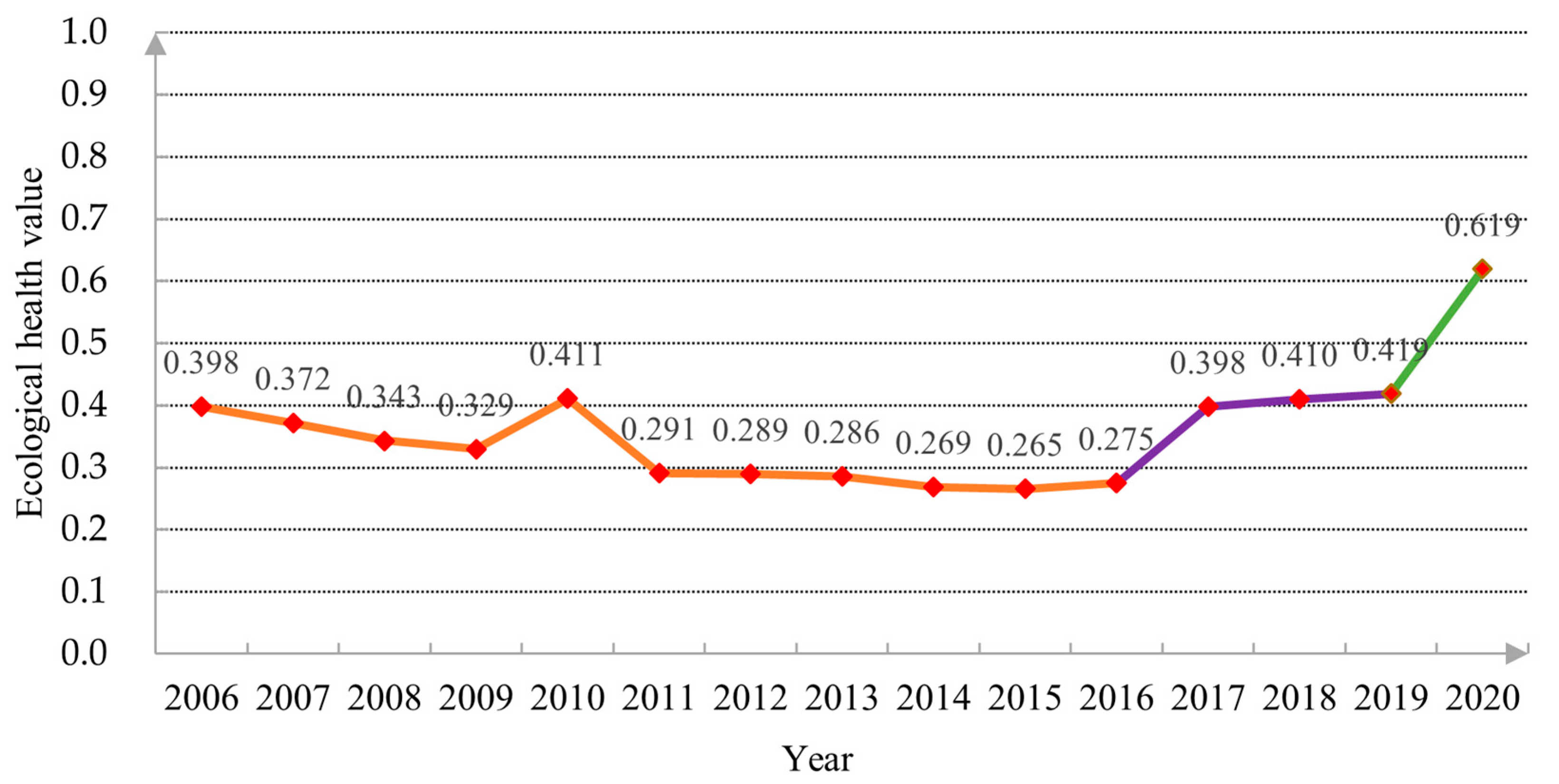
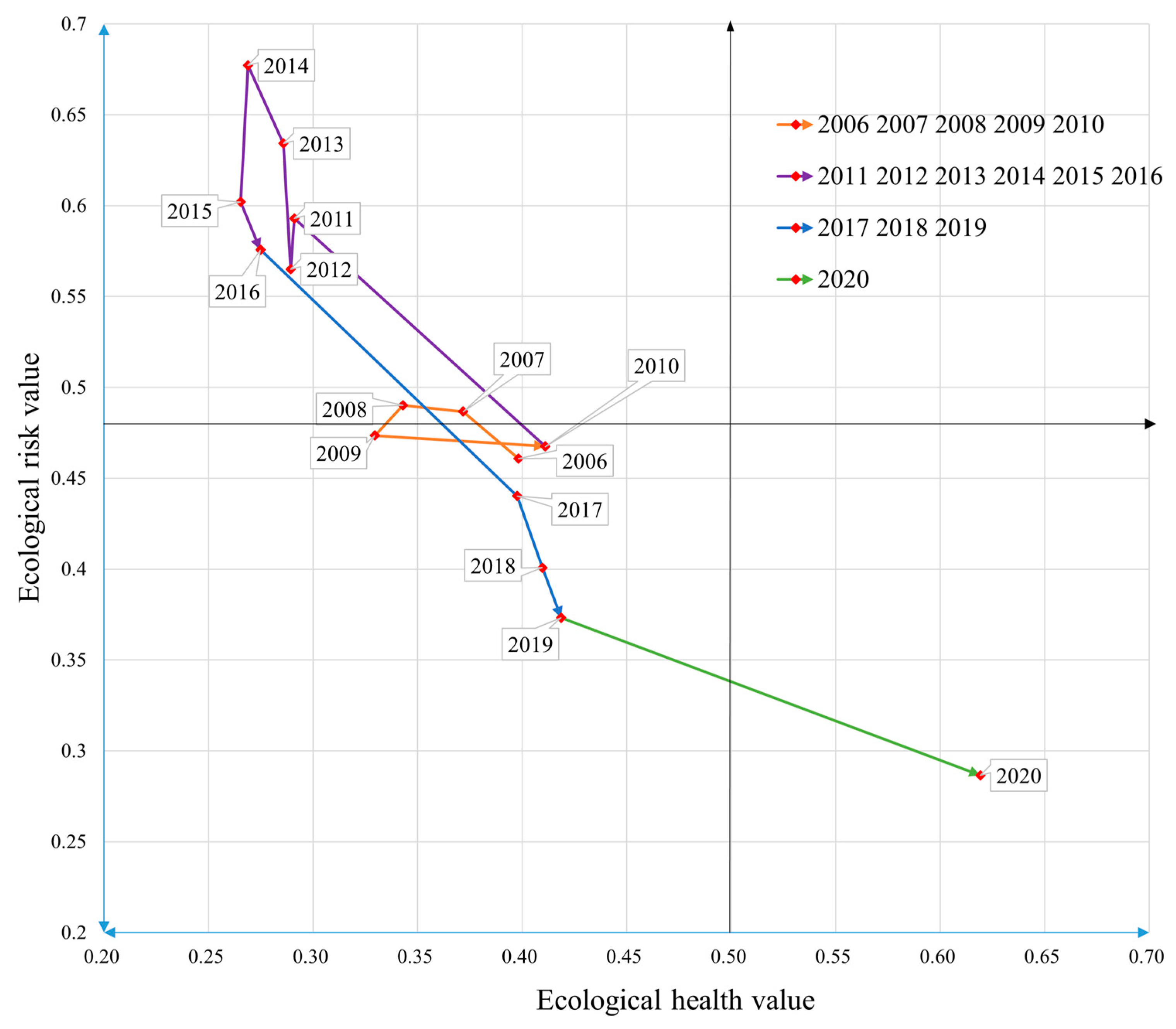
| Destination Layer | Criterion Layer | Index | Units | Criterion Attribute | Weight |
|---|---|---|---|---|---|
| Land ecological risk assessment | Risk source (A1) | Amount of fertilizer used (B1) | 104 tons | + | 0.1396 |
| Amount of pesticide used (B2) | 104 tons | + | 0.0769 | ||
| Amount of plastic film used in agriculture (B3) | 104 tons | + | 0.0637 | ||
| Amount of sewage discharge (B4) | 104 m3 | + | 0.0783 | ||
| Area prone to flooding (B5) | 103 hm2 | + | 0.0615 | ||
| Risk receptor (A2) | Area affected by soil erosion (B6) | km2 | + | 0.0864 | |
| Area of land used for planting crops (B7) | 103 hm2 | − | 0.0751 | ||
| Effective irrigated area of farmland (B8) | 103 hm2 | − | 0.1057 | ||
| Risk effect (A3) | Area covered by urban greenery (B9) | hm2 | − | 0.0753 | |
| Forest coverage rate (B10) | % | − | 0.0595 | ||
| Expenditure on disaster prevention and emergency management (B11) | 104 | − | 0.0256 | ||
| Rate of harmless treatment of domestic waste (B12) | % | − | 0.0409 | ||
| Area of soil-erosion control (B13) | km2 | − | 0.0539 | ||
| Area of waterlogging control (B14) | 103 hm2 | − | 0.0574 |
| Destination Layer | Criterion Layer | Index | Units | Criterion Attribute | Weight |
|---|---|---|---|---|---|
| Land ecological health system | Land ecological elasticity (C1) | Cultivated land pressure index (D1) | % | − | 0.0265 |
| Forest coverage rate (D2) | % | + | 0.0665 | ||
| Surface water resources (D3) | 108 m3 | + | 0.0621 | ||
| Groundwater resources (D4) | 108 m3 | + | 0.0478 | ||
| Land ecological vitality (C2) | Effective irrigated area of farmland (D5) | 103 hm2 | + | 0.0921 | |
| Area covered by urban greenery in built-up areas (D6) | hm2 | + | 0.1240 | ||
| Per capita area of urban park green space (D7) | km2 | + | 0.0467 | ||
| Rate of harmless treatment of domestic waste (D8) | % | + | 0.0680 | ||
| Land ecological health system | Land ecological structure (C3) | Proportion of primary industry (D9) | % | + | 0.0537 |
| Area of land used for planting crops (D10) | 103 hm2 | + | 0.0437 | ||
| Proportion of effective phosphorus in fertilized areas (D11) | % | − | 0.0397 | ||
| Proportion of organic matter in fertilized areas (D12) | % | + | 0.0339 | ||
| Land surface pollution source (C4) | Amount of nitrogen fertilizer applied (D13) | tons | − | 0.0585 | |
| Amount of phosphate fertilizer applied (D14) | tons | − | 0.0771 | ||
| Amount of agricultural plastic film applied (D15) | tons | − | 0.0576 | ||
| Amount of agricultural diesel fuel applied (D16) | tons | − | 0.1022 |
| Year | Positive Ideal Solution Distance (D+) | Negative Ideal Solution Distance (D−) | Composite Score Index | Ranking |
|---|---|---|---|---|
| 2006 | 0.450411 | 0.297993 | 0.398171 | 5 |
| 2007 | 0.437319 | 0.258840 | 0.371812 | 7 |
| 2008 | 0.439717 | 0.229607 | 0.343043 | 8 |
| 2009 | 0.441545 | 0.216952 | 0.329465 | 9 |
| 2010 | 0.417901 | 0.291688 | 0.411066 | 3 |
| 2011 | 0.471244 | 0.193371 | 0.290952 | 10 |
| 2012 | 0.481157 | 0.195835 | 0.289272 | 11 |
| 2013 | 0.492107 | 0.196845 | 0.285717 | 12 |
| 2014 | 0.497735 | 0.182917 | 0.268738 | 14 |
| 2015 | 0.487501 | 0.176108 | 0.265379 | 15 |
| 2016 | 0.472374 | 0.178946 | 0.274744 | 13 |
| 2017 | 0.405959 | 0.268074 | 0.397716 | 6 |
| 2018 | 0.393686 | 0.273146 | 0.409617 | 4 |
| 2019 | 0.413533 | 0.297684 | 0.418556 | 2 |
| 2020 | 0.283882 | 0.461719 | 0.619257 | 1 |
| Health Status | Unhealthy | Less Healthy | Critical Health | Healthier | Healthy |
|---|---|---|---|---|---|
| 0.00~0.20 | 0.21~0.40 | 0.41~0.60 | 0.61~0.80 | 0.81~1.00 |
| Year | Ecological Risk Value | Ecological Health Value | Ecological Security Status |
|---|---|---|---|
| 2006 | 0.461 | 0.398 | Relative safe |
| 2007 | 0.487 | 0.372 | Relative safe |
| 2008 | 0.490 | 0.343 | Relative safe |
| 2009 | 0.474 | 0.329 | Relative safe |
| 2010 | 0.468 | 0.411 | Relative safe |
| 2011 | 0.593 | 0.291 | Unsafe |
| 2012 | 0.565 | 0.289 | Unsafe |
| 2013 | 0.634 | 0.286 | Unsafe |
| 2014 | 0.677 | 0.269 | Unsafe |
| 2015 | 0.602 | 0.265 | Unsafe |
| 2016 | 0.576 | 0.275 | Unsafe |
| 2017 | 0.440 | 0.398 | Relative safe |
| 2018 | 0.401 | 0.410 | Relative safe |
| 2019 | 0.373 | 0.419 | Relative safe |
| 2020 | 0.287 | 0.619 | Safe |
| Year | 1 | 2 | 3 | |||
|---|---|---|---|---|---|---|
| Criterion Layer | Obstacle Degree (%) | Criterion Layer | Obstacle Degree (%) | Criterion Layer | Obstacle Degree (%) | |
| 2006 | A3 | 36.56 | A1 | 34.43 | A2 | 29.01 |
| 2007 | A3 | 37.48 | A1 | 32.22 | A2 | 30.29 |
| 2008 | A3 | 37.56 | A1 | 32.90 | A2 | 29.53 |
| 2009 | A3 | 37.19 | A1 | 35.06 | A2 | 27.75 |
| 2010 | A1 | 34.75 | A3 | 32.90 | A2 | 32.36 |
| 2011 | A3 | 51.68 | A1 | 31.84 | A2 | 16.49 |
| 2012 | A3 | 44.85 | A2 | 32.14 | A1 | 23.01 |
| 2013 | A3 | 61.99 | A2 | 24.98 | A1 | 13.03 |
| 2014 | A3 | 50.48 | A2 | 36.85 | A1 | 12.68 |
| 2015 | A2 | 38.22 | A3 | 37.77 | A1 | 24.01 |
| 2016 | A2 | 40.15 | A3 | 35.73 | A1 | 24.12 |
| 2017 | A2 | 40.04 | A1 | 30.17 | A3 | 29.79 |
| 2018 | A2 | 37.75 | A1 | 33.05 | A3 | 29.20 |
| 2019 | A2 | 37.84 | A1 | 34.01 | A3 | 28.15 |
| 2020 | A2 | 46.97 | A1 | 35.94 | A3 | 17.09 |
| Year | 1 | 2 | 3 | 4 | 5 | |||||
|---|---|---|---|---|---|---|---|---|---|---|
| Factor | Obstacle Degree (%) | Factor | Obstacle Degree (%) | Factor | Obstacle Degree (%) | Factor | Obstacle Degree (%) | Factor | Obstacle Degree (%) | |
| 2006 | B7 | 14.42 | B4 | 13.75 | B1 | 12.97 | B9 | 11.82 | B6 | 10.37 |
| 2007 | B7 | 14.25 | B4 | 13.68 | B9 | 12.61 | B1 | 12.55 | B6 | 11.57 |
| 2008 | B7 | 14.93 | B1 | 14.38 | B4 | 13.44 | B9 | 13.34 | B6 | 10.87 |
| 2009 | B4 | 17.25 | B7 | 14.29 | B9 | 14.02 | B1 | 13.92 | B6 | 11.46 |
| 2010 | B4 | 18.30 | B7 | 15.94 | B9 | 15.89 | B6 | 15.28 | B12 | 12.81 |
| 2011 | B4 | 19.16 | B12 | 17.20 | B9 | 17.13 | B7 | 15.47 | B10 | 8.43 |
| 2012 | B12 | 17.97 | B6 | 17.29 | B4 | 15.06 | B7 | 14.45 | B10 | 8.81 |
| 2013 | B14 | 20.88 | B13 | 18.37 | B6 | 16.69 | B12 | 9.67 | B4 | 8.88 |
| 2014 | B14 | 17.39 | B8 | 17.27 | B6 | 16.92 | B13 | 15.41 | B4 | 8.29 |
| 2015 | B6 | 20.37 | B8 | 16.15 | B5 | 14.98 | B14 | 14.38 | B4 | 7.57 |
| 2016 | B6 | 21.34 | B8 | 16.92 | B5 | 15.70 | B14 | 15.07 | B13 | 7.43 |
| 2017 | B6 | 22.24 | B5 | 16.36 | B8 | 16.22 | B14 | 14.76 | B13 | 7.68 |
| 2018 | B6 | 21.39 | B8 | 16.36 | B5 | 15.69 | B14 | 14.19 | B1 | 7.01 |
| 2019 | B6 | 21.34 | B8 | 15.81 | B5 | 15.62 | B14 | 14.16 | B1 | 9.98 |
| 2020 | B6 | 25.63 | B8 | 20.60 | B1 | 13.49 | B5 | 11.66 | B14 | 9.55 |
| Year | 1 | 2 | 3 | 4 | ||||
|---|---|---|---|---|---|---|---|---|
| Obstacle Degree (%) | Ranking | Obstacle Degree (%) | Ranking | Obstacle Degree (%) | Ranking | Obstacle Degree (%) | Ranking | |
| 2006 | 34.75 | C2 | 27.94 | C4 | 19.57 | C1 | 17.74 | C3 |
| 2007 | 36.44 | C2 | 24.68 | C4 | 19.53 | C1 | 36.44 | C2 |
| 2008 | 35.99 | C2 | 22.73 | C1 | 22.33 | C4 | 18.95 | C3 |
| 2009 | 43.11 | C2 | 20.72 | C3 | 19.36 | C1 | 16.81 | C4 |
| 2010 | 48.14 | C2 | 22.80 | C3 | 19.85 | C4 | 9.20 | C1 |
| 2011 | 44.56 | C2 | 24.97 | C1 | 19.02 | C3 | 11.45 | C4 |
| 2012 | 40.29 | C2 | 32.14 | C1 | 21.43 | C3 | 6.14 | C4 |
| 2013 | 40.46 | C2 | 36.63 | C1 | 19.23 | C3 | 3.68 | C4 |
| 2014 | 53.46 | C2 | 29.68 | C1 | 13.54 | C3 | 3.32 | C4 |
| 2015 | 47.13 | C2 | 33.61 | C1 | 12.57 | C3 | 6.69 | C4 |
| 2016 | 48.69 | C2 | 31.52 | C1 | 12.98 | C3 | 6.81 | C4 |
| 2017 | 47.09 | C2 | 22.05 | C1 | 11.73 | C3 | 19.13 | C4 |
| 2018 | 40.08 | C2 | 24.72 | C4 | 10.85 | C3 | 24.35 | C1 |
| 2019 | 30.91 | C1 | 30.17 | C2 | 28.31 | C4 | 10.61 | C3 |
| 2020 | 40.92 | C4 | 23.65 | C1 | 22.77 | C2 | 12.65 | C3 |
| Year | 1 | 2 | 3 | 4 | 5 | |||||
|---|---|---|---|---|---|---|---|---|---|---|
| Factor | Obstacle Degree (%) | Factor | Obstacle Degree (%) | Factor | Obstacle Degree (%) | Factor | Obstacle Degree (%) | Factor | Obstacle Degree (%) | |
| 2006 | D6 | 18.75 | D16 | 15.45 | D15 | 8.71 | D2 | 8.48 | D8 | 8.10 |
| 2007 | D6 | 19.49 | D16 | 15.06 | D8 | 8.88 | D2 | 7.20 | D3 | 7.09 |
| 2008 | D6 | 20.14 | D16 | 12.85 | D2 | 9.34 | D8 | 7.99 | D3 | 7.45 |
| 2009 | D6 | 23.96 | D8 | 10.86 | D16 | 8.17 | D3 | 7.99 | D7 | 6.80 |
| 2010 | D6 | 27.00 | D8 | 12.31 | D7 | 8.00 | D16 | 7.54 | D2 | 7.36 |
| 2011 | D6 | 23.70 | D8 | 13.44 | D2 | 12.02 | D3 | 7.83 | D7 | 6.81 |
| 2012 | D6 | 24.89 | D8 | 15.14 | D2 | 13.54 | D3 | 10.28 | D9 | 7.84 |
| 2013 | D6 | 26.40 | D3 | 14.18 | D8 | 13.54 | D4 | 10.80 | D9 | 8.47 |
| 2014 | D6 | 22.83 | D5 | 18.88 | D3 | 11.98 | D8 | 11.15 | D4 | 9.50 |
| 2015 | D6 | 21.76 | D5 | 17.78 | D2 | 12.80 | D3 | 10.91 | D9 | 7.56 |
| 2016 | D6 | 18.14 | D5 | 17.21 | D3 | 10.99 | D2 | 10.39 | D7 | 8.87 |
| 2017 | D6 | 19.74 | D5 | 17.24 | D9 | 10.40 | D7 | 8.75 | D14 | 8.07 |
| 2018 | D6 | 16.94 | D5 | 15.90 | D14 | 9.85 | D9 | 9.77 | D3 | 8.50 |
| 2019 | D6 | 13.80 | D5 | 13.42 | D14 | 11.28 | D2 | 10.56 | D3 | 9.86 |
| 2020 | D5 | 20.19 | D14 | 16.95 | D13 | 12.85 | D3 | 10.21 | D9 | 9.51 |
Disclaimer/Publisher’s Note: The statements, opinions and data contained in all publications are solely those of the individual author(s) and contributor(s) and not of MDPI and/or the editor(s). MDPI and/or the editor(s) disclaim responsibility for any injury to people or property resulting from any ideas, methods, instructions or products referred to in the content. |
© 2023 by the authors. Licensee MDPI, Basel, Switzerland. This article is an open access article distributed under the terms and conditions of the Creative Commons Attribution (CC BY) license (https://creativecommons.org/licenses/by/4.0/).
Share and Cite
Li, Y.; Lian, Z.; Zhai, T.; Xie, X.; Wang, Y.; Li, M. Assessment of Land Ecological Security Based on the Boston Model: A Case Study from China. Land 2023, 12, 1348. https://doi.org/10.3390/land12071348
Li Y, Lian Z, Zhai T, Xie X, Wang Y, Li M. Assessment of Land Ecological Security Based on the Boston Model: A Case Study from China. Land. 2023; 12(7):1348. https://doi.org/10.3390/land12071348
Chicago/Turabian StyleLi, Yingchao, Zhongkang Lian, Tianlin Zhai, Xiaotong Xie, Yuchen Wang, and Minghui Li. 2023. "Assessment of Land Ecological Security Based on the Boston Model: A Case Study from China" Land 12, no. 7: 1348. https://doi.org/10.3390/land12071348
APA StyleLi, Y., Lian, Z., Zhai, T., Xie, X., Wang, Y., & Li, M. (2023). Assessment of Land Ecological Security Based on the Boston Model: A Case Study from China. Land, 12(7), 1348. https://doi.org/10.3390/land12071348







